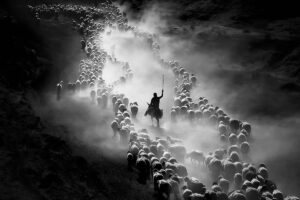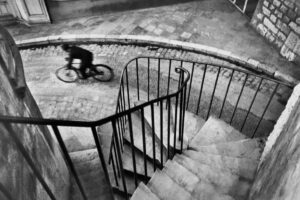![]()
When a lake-effect snowstorm hit Erie, Pennsylvania after Thanksgiving, Pittsburgh-based freelancer Jeff Swensen drove 130 miles to make widely published photos for Getty Images.
A veteran photojournalist who has documented many challenging assignments — including the attempted assassination of Donald Trump — Swensen shares how he covered the snow dump in Erie.
The storm was “unprecedented” in intensity, said the city’s assistant fire chief, Gregory Purchase. More than 200 cars were left abandoned, as the city was buried under several feet of snow.
 People shovel snow from the sidewalk in front of a house in Erie, Pennsylvania on Monday, December 2. | © Jeff Swensen / Getty Images
People shovel snow from the sidewalk in front of a house in Erie, Pennsylvania on Monday, December 2. | © Jeff Swensen / Getty ImagesReadiness
Swensen used verbs sparingly when describing preparation to photograph the storm’s impact in Erie (population 92,957 in 2023):
“A full tank of gas, windshield wiper fluid, Carhartt overalls, muck boots, good gloves and hat, water, food, 4-wheel drive,” says Swensen. “I throw a shovel in the bed of truck. In worst case, I can shovel snow into back to add weight to rear wheels.”
 Riley Coblentz, 13, shovels the sidewalk in front of her friend’s house in Erie, Pa., after a record snowfall. | © Jeff Swensen / Getty Images
Riley Coblentz, 13, shovels the sidewalk in front of her friend’s house in Erie, Pa., after a record snowfall. | © Jeff Swensen / Getty ImagesHe also took a sleeping bag and a Goal Zero 1,000-watt battery.
“The good news is that often the low pressure systems dumping snow tend to be warmer air than frigid Arctic high pressure systems,” Swensen says.
Equipment and Lighting
“Snow is a highlight” he says, “but can be exposed to have detail. Try a bunch of images until it works for your taste.”
For the Erie snowstorm assignment, Swensen was equipped with two Nikon Z8 cameras with lenses ranging from 14mm-400mm, a flash, remote, and a tripod.
 A buried vehicle along the shore of Lake Erie. | © Jeff Swensen / Getty Images
A buried vehicle along the shore of Lake Erie. | © Jeff Swensen / Getty ImagesWhat the Photographer Looks For
Swensen’s photos from Erie were published by leading news outlets including The Washington Post, network news sites, AOL, Yahoo, and more.
“Like every assignment to feature impact of weather on a large area,” Swensen said, “I tried to find where the most pertinent images might be, within time limitations.”
 © Jeff Swensen / Getty Images
© Jeff Swensen / Getty Images“I drove 130 miles to Erie and then close to 40 miles before making the first photo.”
Returning to Erie, he parked in a neighborhood and started making pictures of people digging out. Swensen’s next destination: nearby Lake Erie, where he filed images and videoclips.
“I waited on the shoreline for evening light. When a snow squall kicked up, I put a wide lens on and pulled out a flash on a cord. The flash lit the snow in foreground and air and slow exposure brought it darkening background,” said Swensen.
 A squall kicks up along the waterfront of Lake Erie after a record snowfall left more than three feet on the ground December 2 in Erie, Pennsylvania. As of Monday morning, some parts of Erie County had received up to 60 inches of snow, according to unofficial reports from the National Weather Service. | © Jeff Swensen / Getty Images
A squall kicks up along the waterfront of Lake Erie after a record snowfall left more than three feet on the ground December 2 in Erie, Pennsylvania. As of Monday morning, some parts of Erie County had received up to 60 inches of snow, according to unofficial reports from the National Weather Service. | © Jeff Swensen / Getty ImagesAdvice for Others
“Stay warm, have fun, be safe, and make all sorts of attempts with fast and slow shutter, limited or full depth of field and early or late light,” Swensen recommends.
Plus, he suggests following Washington Post Photojournalist Matt McClain on Instagram.
“He is a master of this,” say Swensen.
 Travis Trojan, 36, shovels in front of his home on Monday after a record snowfall left over three feet in Erie, Pennsylvania. | © Jeff Swensen / Getty Images
Travis Trojan, 36, shovels in front of his home on Monday after a record snowfall left over three feet in Erie, Pennsylvania. | © Jeff Swensen / Getty ImagesCredentials
Swensen is a board member of Kentucky-based Boyd’s Station, a nonprofit arts and journalism residency program in Harrison County, Kentucky. Its website describes Swensen as “a sucker for busy photo editors with challenging assignments on tight deadlines who still require good light on rainy days and varieties of the human condition in difficult situations.”
 Photographer Jeff Swensen
Photographer Jeff SwensenSwensen was trained at the graduate program at Ohio University’s School of Visual Communication. His son Michael Swensen is also a photojournalist; Michael’s photo of former President Trump visiting East Palestine, Ohio after a train wreck was included in TIME Magazine’s top 100 photos of 2023.
Image credits: All photographs by Jeff Swensen, Getty Images
About the author: Ken Klein lives in Silver Spring, Maryland; he is retired after a career in politics, lobbying, and media including The Associated Press and Gannett in Florida. Klein is an alumnus of Ohio University and a member of the Dean’s Advisory Council of the Scripps College of Communication. Professionally, he has worked for Fort Myers News-Press (Gannett), The Associated Press (Tallahassee), Senator Bob Graham, and the Outdoor Advertising Association of America (OAAA).






 English (US) ·
English (US) ·